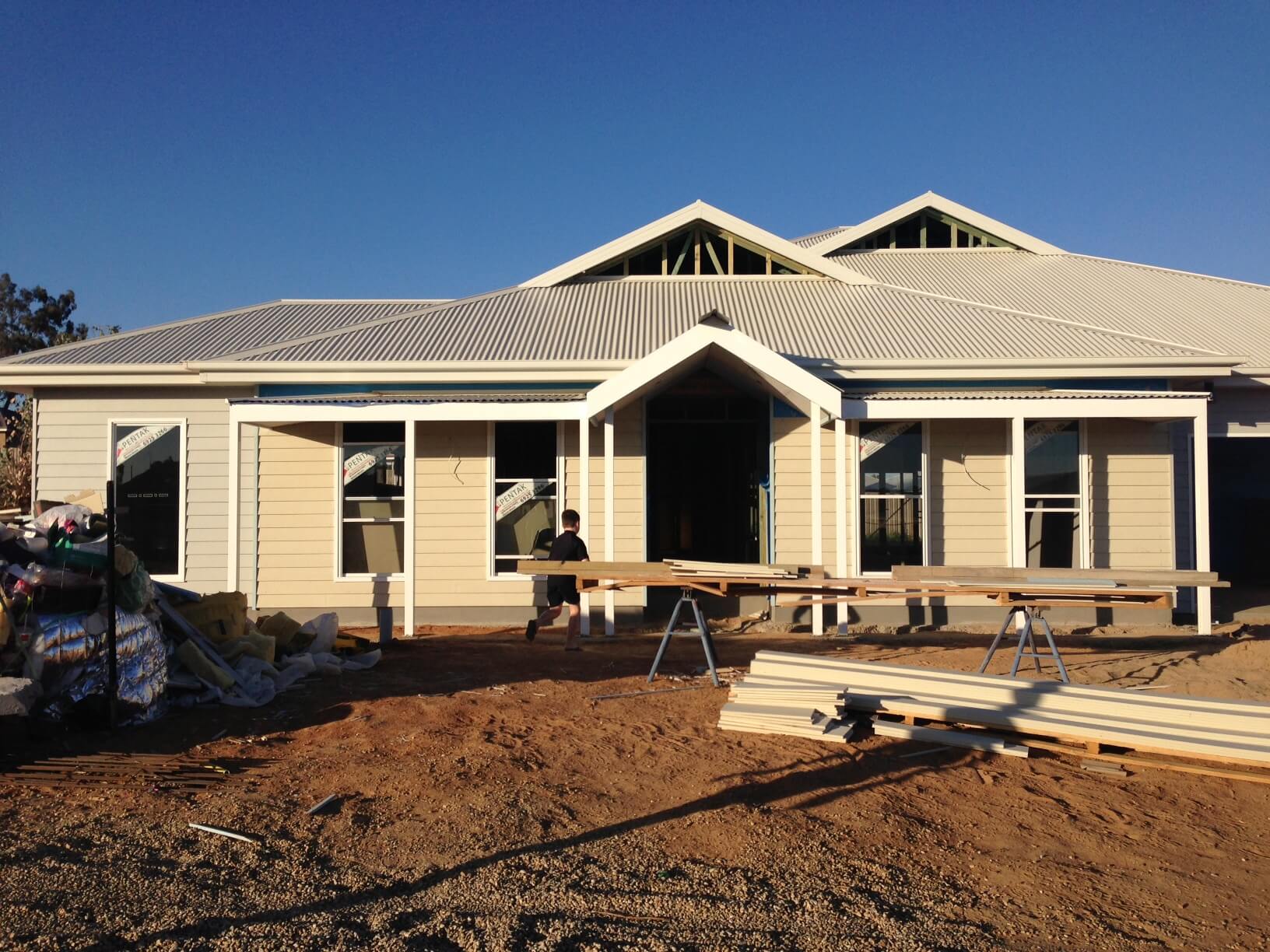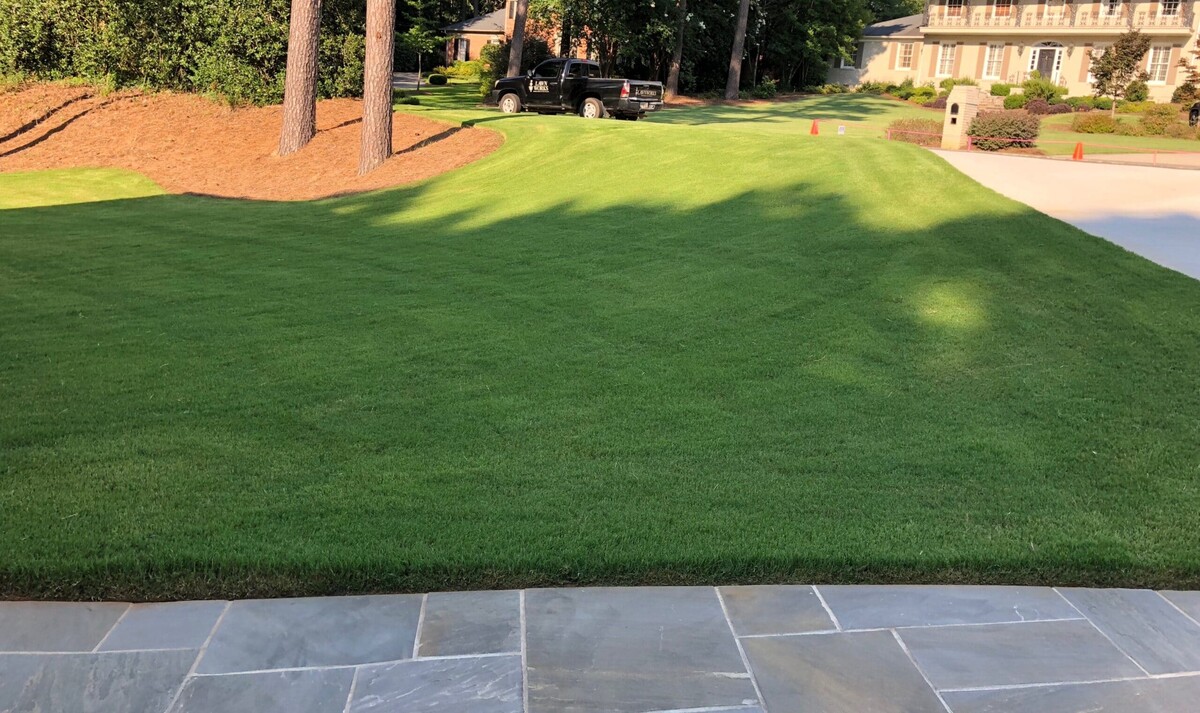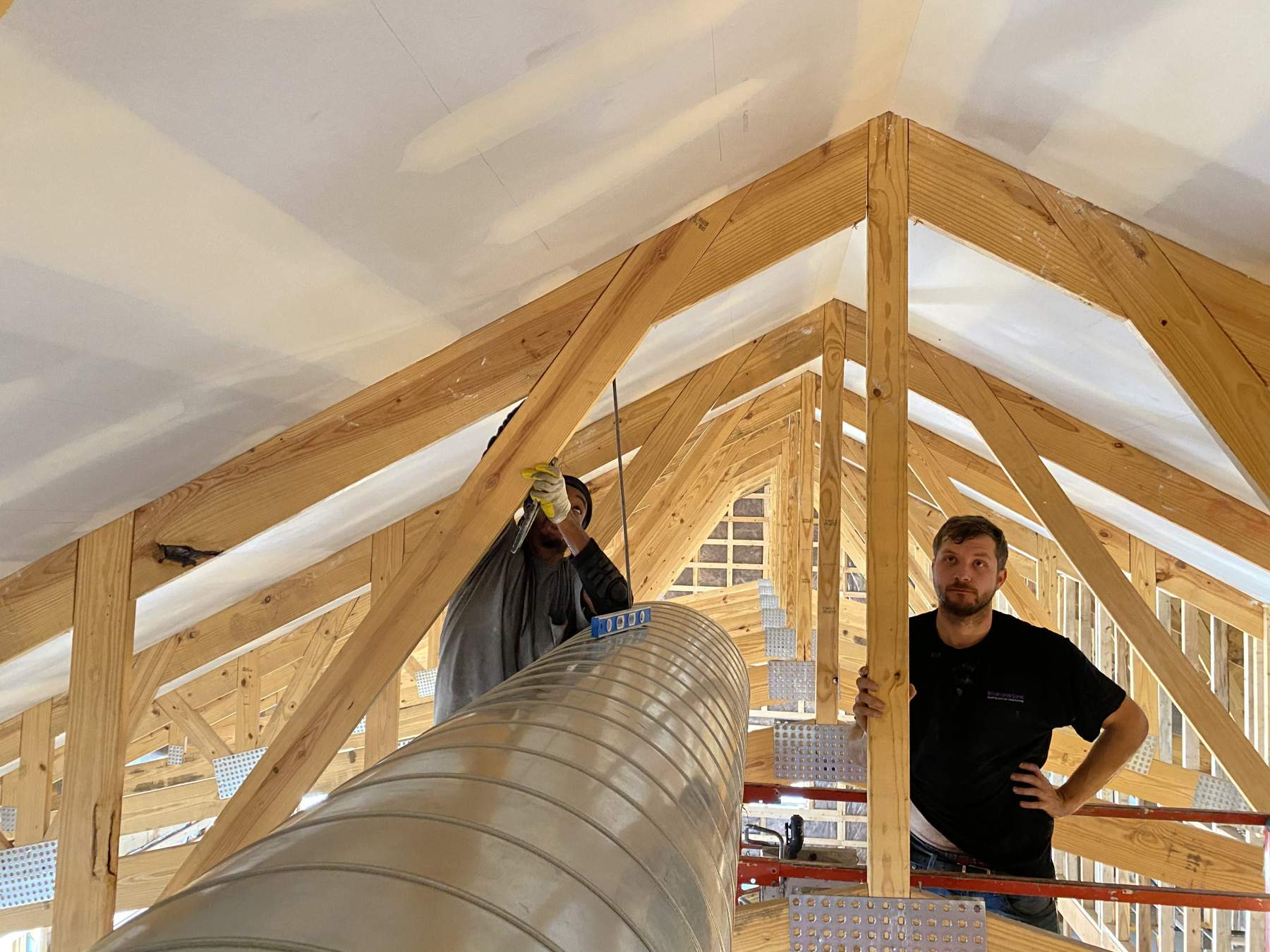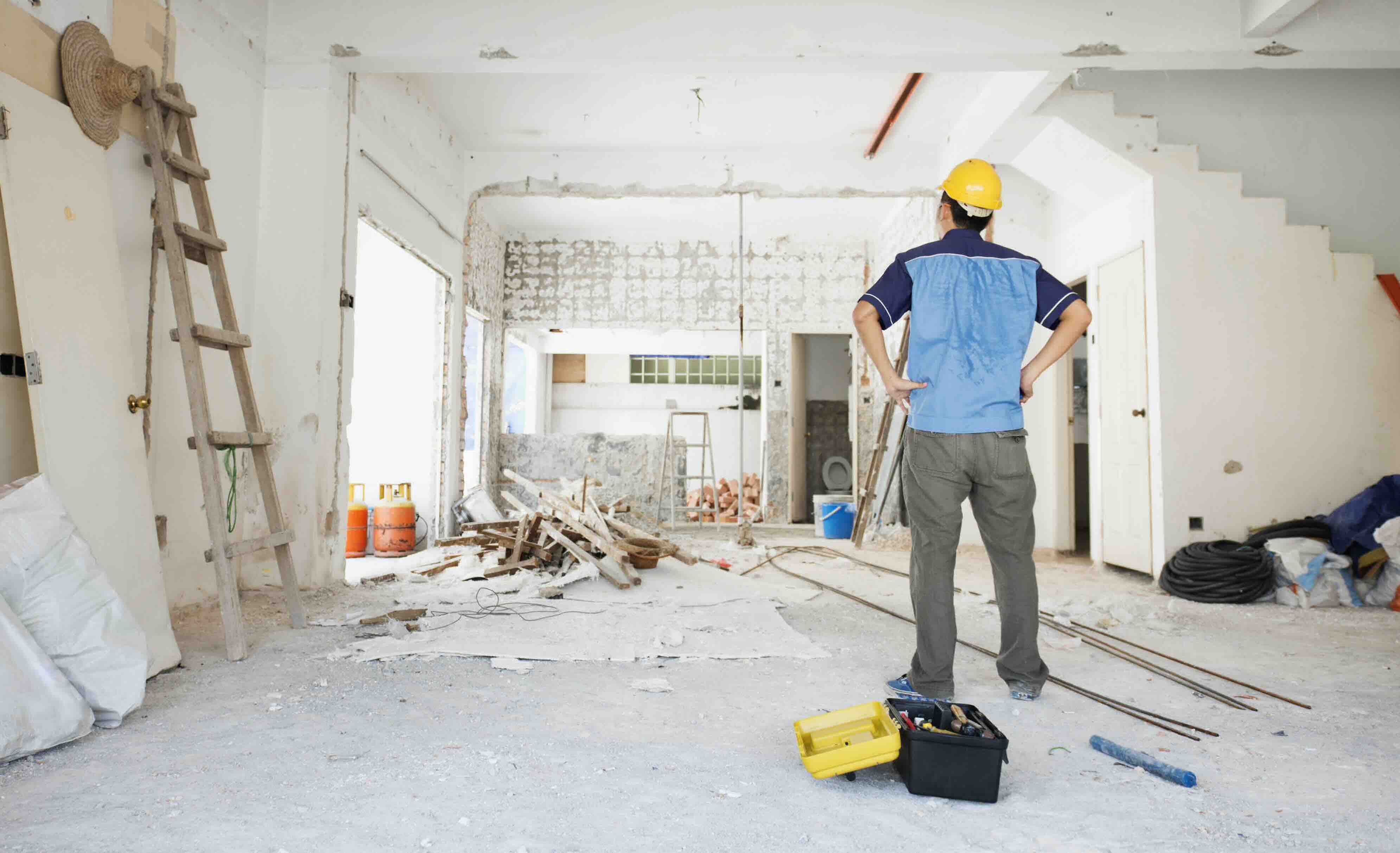Home>diy>Building & Construction>Tips When Building A New Home


Building & Construction
Tips When Building A New Home
Modified: January 20, 2024
Discover valuable tips and expert advice for building your dream home. From construction techniques to design considerations, our guide will help you navigate the building process with ease.
(Many of the links in this article redirect to a specific reviewed product. Your purchase of these products through affiliate links helps to generate commission for Storables.com, at no extra cost. Learn more)
Introduction
Building a new home is an exciting endeavor that allows you to create your dream living space. Whether you’re a first-time homeowner or looking to upgrade to a custom-designed house, the process can be both fulfilling and challenging. To ensure a successful construction project, it’s essential to have a clear understanding of the steps involved and make informed decisions along the way.
In this article, we will provide you with comprehensive tips and guidance for building a new home. From selecting the right location to choosing the materials and finishes, we’ll cover all crucial aspects to help you create a home that meets your needs, reflects your style, and stands the test of time. So let’s dive in and explore the key factors to consider when embarking on this exciting journey.
Key Takeaways:
- Building a new home involves careful planning, attention to detail, and a vision for the future. From choosing the right location to completing final inspections, each step is crucial for success.
- Turning a newly built house into a home is a journey that requires patience, creativity, and a passion for creating a living space that truly represents you. Embrace the process and take pride in the accomplishment of building your dream home.
Read more: Checklist When Building A New Home
Choosing the Right Location
The location of your new home is one of the most important factors to consider. It not only determines the convenience and accessibility of your daily life but also plays a significant role in determining the long-term value and appreciation of your property. Here are some key considerations when choosing the right location:
- Neighborhood and Amenities: Research the neighborhood to ensure it aligns with your lifestyle and preferences. Look for amenities such as schools, parks, shopping centers, and proximity to healthcare facilities.
- Commute: Consider how long it will take to commute to work or other frequently visited places. Evaluate the availability of public transportation options and road infrastructure.
- Future Development: Investigate any plans for future development in the area. This can impact your quality of life and property value.
- Natural Surroundings: Take into account the natural surroundings, such as scenic views, proximity to water bodies, or access to recreational areas.
It’s also crucial to assess the potential impact of the location on your budget. Depending on the area, land prices and construction costs may vary significantly. Conduct thorough research, consider your budgetary constraints, and weigh the pros and cons of different locations before making a decision.
Remember, choosing the right location sets the foundation for a successful home building project and enhances your overall quality of life. Take your time, explore different options, and evaluate each location based on your priorities and future plans.
Setting a Realistic Budget
Setting a realistic budget is a crucial step when building a new home. It helps you determine the scope of your project, avoid financial hardship, and ensure that your dream home aligns with your financial capabilities. Here are some tips to help you set a realistic budget:
- Evaluate Your Finances: Assess your financial situation and determine how much you can comfortably allocate towards building your new home. Consider your savings, income, and any loans or financing options available to you.
- Consider Hidden Costs: Apart from the actual construction costs, there are several hidden expenses that you need to account for. These may include permits, inspections, landscaping, utility connections, legal fees, and furnishing.
- Consult Professionals: Reach out to builders, architects, and other professionals in the industry to get estimates and guidance on construction costs. They can help you understand the average costs associated with building a home of your desired size and specifications.
- Prioritize Your Needs: Identify your must-haves and prioritize your expenses accordingly. This will help you allocate your budget to the essential aspects of your home and make adjustments if needed.
- Be Realistic: It’s important to set a budget that is realistic and aligns with your financial capabilities. Avoid overextending yourself financially, as it can lead to stress and financial strain during and after the construction process.
Once you have established a budget, make sure to track your expenses throughout the construction process. Regularly review your budget and compare it to your actual expenditure to ensure that you stay on track. Be prepared for unexpected costs that may arise during construction and have a contingency fund in place to handle any unforeseen circumstances.
Remember, setting a realistic budget is essential for a smooth and successful home building process. It helps you make informed decisions, prioritize your expenses, and ensures that your dream home becomes a reality within your financial means.
Finding the Right Builder
Choosing the right builder is one of the most critical decisions you’ll make when building a new home. They will be responsible for turning your vision into a reality and ensuring that the construction process runs smoothly. Here are some key considerations to help you find the right builder:
- Check Reputation and Experience: Research the builder’s reputation and experience in the industry. Look for online reviews, client testimonials, and ask for references from their previous clients. A builder with a good track record is more likely to deliver quality work.
- License and Insurance: Ensure that the builder is properly licensed and insured. This protects you from any liability and ensures that the construction work is carried out by qualified professionals.
- Portfolio and Style: Review the builder’s portfolio to assess the quality and style of their previous projects. Make sure their style aligns with your vision and desired architectural aesthetics.
- Communication and Transparency: Effective communication is crucial during the construction process. Choose a builder who is responsive, transparent, and keeps you updated on the progress of your project. They should be willing to answer your questions and address any concerns promptly.
- Contracts and Timelines: Review the builder’s contracts and timelines thoroughly. Ensure that they clearly outline the scope of work, payment schedules, and project milestones. This protects both parties involved and helps prevent disputes.
- Cost and Value: While cost is an important factor, don’t solely base your decision on the lowest price. Consider the overall value offered by the builder, including their expertise, reputation, and the quality of materials and finishes they use.
It’s also beneficial to visit homes built by the builder to get a firsthand experience of their craftsmanship and attention to detail. This will further help you assess their work quality and determine if they are the right fit for your project.
Remember, finding the right builder is crucial for a successful home building project. Take the time to research, ask for recommendations, and interview multiple builders to ensure that you choose a reliable and skilled professional who can bring your dream home to life.
Designing the Layout
The layout of your new home is a key aspect that determines the functionality, flow, and overall appeal of the living space. Designing a well-thought-out layout can enhance the livability of your home and cater to your specific needs. Here are some tips to consider when designing the layout:
- Consider Your Lifestyle: Think about how you and your family live and use the space. Determine if you need open-concept living areas for socializing or separate rooms for privacy and quiet activities.
- Room Arrangement: Plan the location and size of each room carefully. Ensure that there is a logical flow between rooms and that they are appropriately sized for their intended purposes.
- Maximize Natural Light: Incorporate windows and other openings to maximize natural light. This not only enhances the visual appeal but also contributes to a brighter and more inviting atmosphere.
- Consider Future Needs: Think about your future needs and potential changes in your lifestyle. Design your home with flexibility in mind, allowing for potential modifications or conversions as your needs evolve over time.
- Create Functional Spaces: Pay attention to creating functional spaces that cater to specific activities, such as a dedicated home office, laundry room, or storage areas. This ensures that your home meets your practical requirements.
- Flow and Circulation: Aim for a smooth flow and circulation throughout the house. Minimize dead-end areas and create easy access between rooms and outdoor spaces.
When designing the layout, it’s essential to work closely with an architect or a design professional who can help bring your ideas to life and ensure that the design is both aesthetically pleasing and functional. Collaborate with them to create a design that reflects your style, serves your needs, and optimizes the available space.
Remember, a well-designed layout sets the foundation for a comfortable and enjoyable living environment. Take the time to plan and design the layout carefully to create a home that suits your lifestyle and enhances your everyday living experience.
Read more: Mistakes To Avoid When Building A New House
Deciding on the Architectural Style
The architectural style of your new home is an expression of your personal taste and can greatly impact its overall appearance and character. Whether you prefer a traditional, modern, farmhouse, or contemporary style, choosing the right architectural style is an important decision. Here are some factors to consider when deciding on the architectural style:
- Personal Preference: Consider your personal preferences and the styles that resonate with you. Look for inspiration in magazines, online platforms, and by visiting homes with different architectural styles.
- Location and Context: Take into account the surrounding environment and the architectural styles commonly found in the area. While you want your home to stand out, it should also blend harmoniously with its surroundings.
- Design Features: Each architectural style has its distinctive design features. Research and explore different styles to identify the elements and details that you find appealing.
- Budget and Feasibility: Some architectural styles may require specific materials, craftsmanship, or construction techniques, which can impact the overall cost. Consider your budget and feasibility when selecting a style.
- Long-Term Appeal: Think about the longevity of the architectural style. Choose a style that you love now and can imagine enjoying for many years to come.
When making a decision, it’s helpful to work with an architect or a design professional who specializes in the style you’re interested in. They can provide expert guidance, recommend appropriate materials, and ensure that the design reflects the essence of the chosen architectural style.
Remember, the architectural style of your home sets the tone for its overall look and creates a lasting impression. Choose a style that resonates with you, suits your lifestyle, and complements the surrounding environment.
Selecting the Materials and Finishes
The materials and finishes used in your new home play a crucial role in its aesthetics, durability, and overall quality. Careful consideration and selection of materials can enhance the visual appeal and ensure a long-lasting build. Here are some factors to consider when selecting materials and finishes:
- Quality and Durability: Choose high-quality materials that are known for their durability. This includes materials such as hardwood floors, sturdy roofing materials, and weather-resistant siding.
- Style and Aesthetics: Consider the overall style and design of your home when selecting materials. Choose materials that complement the architectural style and create a cohesive look.
- Maintenance and Upkeep: Evaluate the maintenance requirements of various materials. Some might require regular cleaning, sealing, or refinishing, while others are low-maintenance options.
- Sustainability and Eco-Friendliness: Opt for materials that are environmentally friendly and sustainable. Look for options such as recycled or reclaimed materials, energy-efficient windows, and eco-conscious insulation.
- Budget: Consider your budget when selecting materials and finishes. It’s essential to strike a balance between quality and cost-effectiveness.
- Consistency and Coherence: Ensure that the materials and finishes throughout your home create a cohesive and harmonious look. Choose materials that work well together and create a sense of unity.
- Consultation and Samples: Seek advice from professionals and request samples of materials to help visualize how they will look in your home’s context. This allows you to make informed decisions and see how different materials interact with lighting and other elements.
Remember, the materials and finishes you choose will impact not only the aesthetic appeal of your home but also its functionality and longevity. Take the time to research and explore different options, consult with professionals, and choose materials that align with your vision and meet your requirements.
Ensuring Safety and Security Measures
When building a new home, it’s crucial to prioritize safety and security to protect your property and the well-being of occupants. Incorporating appropriate safety and security measures into your home’s design and construction ensures peace of mind. Here are some key considerations:
- Fire Safety: Install smoke detectors on each floor and near bedrooms, as well as carbon monoxide detectors if needed. Plan for multiple exits in case of a fire and ensure that fire-resistant materials are used in construction.
- Security Systems: Consider installing a comprehensive security system that includes alarms, surveillance cameras, and motion sensors. This helps deter intruders and provides protection for your home and belongings.
- Lighting: Ensure that outdoor areas, such as entrances, walkways, and driveways, are well-illuminated to prevent accidents and deter unwanted visitors. Consider motion-activated lights for added security.
- Windows and Doors: Invest in high-quality windows and doors that are equipped with secure locks and shatter-resistant glass. Reinforce entry points and consider adding security film to windows to make them more resistant to break-ins.
- Secure Entryways: Install sturdy and well-fitted doors with deadbolts and reinforced frames. Consider features like peepholes and smart locks for added convenience and security.
- Emergency Preparedness: Have an emergency plan in place and make sure all occupants are aware of it. Install fire extinguishers on each floor and create a designated area for emergency supplies.
- Child Safety: If you have children or are planning to, ensure that your home is childproofed with measures such as safety gates, cabinet locks, and anti-tip furniture straps.
It’s also essential to follow building codes and regulations related to safety measures during the construction process. Work with professionals who are knowledgeable about safety standards and ensure that all safety requirements are met.
Remember, prioritizing safety and security measures in your new home is essential for the well-being of your family and to protect your investment. Take the necessary steps to create a secure environment that gives you peace of mind.
Planning Energy-Efficient Features
Building an energy-efficient home not only helps reduce your carbon footprint but also saves you money on energy bills in the long run. Planning and incorporating energy-efficient features into your new home is a smart investment. Here are some key considerations:
- Insulation: Proper insulation helps regulate the temperature inside your home, reducing the need for excessive heating or cooling. Insulate walls, floors, and attics to minimize energy loss.
- Windows and Glazing: Choose energy-efficient windows with low-emissivity (Low-E) coatings to control the amount of heat and light entering your home. Consider double-glazed or triple-glazed windows for enhanced insulation.
- Heating and Cooling Systems: Install energy-efficient HVAC systems designed to heat and cool your home efficiently. Opt for programmable thermostats to set temperature schedules and reduce energy consumption when you’re not at home.
- Energy-Efficient Lighting: Use LED or CFL light bulbs that consume less energy than traditional incandescent bulbs. Incorporate natural light sources and utilize efficient lighting fixtures to reduce energy consumption.
- Energy-Saving Appliances: Choose energy-efficient appliances, such as refrigerators, dishwashers, washing machines, and dryers. Look for the ENERGY STAR label, which certifies energy efficiency.
- Solar Panels: Consider installing solar panels to generate clean, renewable energy for your home. Solar power can significantly reduce your reliance on the grid and lower your energy bills over time.
- Smart Home Technology: Use smart home technology to control and monitor energy usage. Smart thermostats, lighting systems, and energy monitors allow you to optimize energy efficiency and make adjustments remotely.
- Water Conservation: Install water-saving fixtures such as low-flow faucets, showerheads, and toilets. Consider collecting rainwater for landscaping and use efficient irrigation systems.
Consult with professionals who specialize in energy-efficient design to ensure that your home incorporates the best practices and technologies for energy conservation.
Remember, planning energy-efficient features in your new home promotes sustainability, reduces energy consumption, and ultimately saves you money. Take advantage of available technologies and design principles to create an eco-friendly and energy-efficient living space.
When building a new home, make sure to carefully consider the placement of windows to maximize natural light and minimize energy usage.
Incorporating Smart Home Technology
In today’s digital age, incorporating smart home technology into your new home can greatly enhance convenience, efficiency, and security. From automated systems to voice-controlled devices, smart home technology offers a range of features that simplify everyday tasks and improve your overall living experience. Here are some ways to incorporate smart home technology into your new home:
- Smart Lighting: Install smart lighting systems that can be controlled remotely or programmed to turn on and off at specific times. This allows you to save energy and customize lighting settings to match your preferences.
- Automated Heating and Cooling: Use smart thermostats to regulate temperature settings based on your schedule and preferences. These devices can learn your habits and adjust the temperature accordingly, resulting in energy savings.
- Home Security Systems: Invest in smart security systems that include surveillance cameras, door sensors, and motion detectors. These can be monitored remotely, providing peace of mind and enhanced protection for your home.
- Smart Appliances: Opt for smart appliances, such as refrigerators, ovens, and washing machines, that can be controlled and monitored through smartphone apps. This allows you to manage tasks efficiently and reduce energy consumption.
- Voice-Activated Assistants: Incorporate voice-activated assistants like Amazon Alexa or Google Assistant to control various smart devices in your home. These assistants can play music, answer questions, set reminders, control lighting, and more.
- Smart Entertainment Systems: Set up a home theater system or multi-room audio that can be controlled from your smartphone or voice-activated assistant. This allows you to enjoy immersive entertainment experiences at the touch of a button.
- Smart Irrigation Systems: Use smart sprinkler systems that monitor weather conditions and adjust the watering schedule accordingly. This saves water and ensures that your plants receive the right amount of moisture.
Before incorporating smart home technology, consider your lifestyle, budget, and compatibility of devices. It’s important to choose devices and systems that seamlessly integrate with each other for optimal performance.
Remember, incorporating smart home technology into your new home adds convenience, efficiency, and modernity. Future-proof your home by embracing these advancements and enjoy the benefits of a connected, intelligent living space.
Allowing for Sufficient Storage
No matter the size of your new home, incorporating sufficient storage space is essential for keeping your living areas organized and clutter-free. Adequate storage ensures that belongings have designated spaces, maximizing functionality and minimizing visual chaos. Here are some tips to consider when planning for sufficient storage:
- Closet Space: Design closets with ample shelving, hanging space, and compartments to accommodate clothing, shoes, and accessories. Consider walk-in closets for master bedrooms to provide even more storage options.
- Kitchen Storage: Optimize kitchen storage by including ample cabinetry, a pantry, and drawer organizers. Utilize vertical space effectively with tall cabinets or overhead storage for less frequently used items.
- Bathroom Storage: Incorporate cabinets, shelves, and vanity units in bathrooms to store toiletries, linens, and cleaning supplies. Utilize vertical storage by installing wall-mounted cabinets or shelving units.
- Laundry Room: Allocate space in the laundry room for storage of laundry supplies, cleaning products, and other household items. Consider cabinets, shelves, or overhead storage to keep the area tidy.
- Multi-Purpose Furniture: Opt for furniture pieces that double as storage, such as ottomans with hidden compartments or beds with built-in drawers. This maximizes space utilization, especially in smaller rooms.
- Garage or Basement: If you have a garage or basement, include storage solutions such as wall-mounted shelving, cabinets, or overhead racks to keep tools, equipment, and seasonal items organized.
- Entryway Organization: Create a designated space near the entryway for storing shoes, jackets, keys, and other essentials. Install hooks, benches with storage compartments, or wall-mounted organizers for efficiency.
- Customized Storage Solutions: Consider custom-built storage solutions tailored to your specific needs. This could include built-in bookshelves, cubbies, or specialized storage for hobbies or collections.
Don’t forget to assess your storage needs and prioritize organization throughout the home. Plan for future storage requirements, taking into account potential changes in your lifestyle or growing family.
Remember, sufficient storage is essential for a well-organized and functional home. By incorporating thoughtful storage solutions, you can ensure that every item has its place and enjoy a clutter-free living environment.
Creating Functional Outdoor Spaces
When building a new home, it’s important to consider the design and functionality of your outdoor spaces. Whether you have a small backyard or a spacious courtyard, creating functional outdoor areas allows you to enjoy the beauty of nature and extend your living space. Here are some tips to consider when designing outdoor spaces:
- Outdoor Entertaining: Plan for a designated area where you can entertain guests, such as a patio or deck. Include seating, a dining area, and perhaps a barbecue or outdoor kitchen for al fresco dining.
- Garden and Landscaping: Design a garden that suits your taste and maintenance preferences. Consider incorporating flower beds, shrubs, trees, and a mix of hardscaping elements to create a visually appealing outdoor environment.
- Privacy: Take privacy into account when designing outdoor spaces. Utilize fencing, landscaping, or pergolas with climbing plants to create secluded areas where you can relax and unwind.
- Functional Pathways: Create pathways that connect different areas of your outdoor space, such as a path from the patio to the garden or a walkway around the house. Use natural stones, pavers, or gravel to add character and functionality.
- Water Features: Consider incorporating a water feature, such as a fountain, pond, or waterfall, to add tranquility and a pleasing visual element to your outdoor space.
- Outdoor Lighting: Install outdoor lighting to enhance the ambiance and functionality of your outdoor spaces. Use a combination of pathway lighting, accent lighting, and overhead lighting for safety and aesthetics.
- Recreational Areas: If you have space, create areas for recreational activities such as a playground, a swimming pool, or a sports court. These additions can provide hours of enjoyment for your family and friends.
- Seasonal Considerations: Think about how you will use your outdoor spaces throughout the year. Incorporate features like a fire pit or outdoor heaters for cooler seasons, and provide shade options in hot climates.
When designing outdoor spaces, consider your personal preferences, climate, and budget. Work with a landscape architect or design professional to ensure that your vision is brought to life and that the outdoor areas seamlessly integrate with the overall design of your home.
Remember, well-designed outdoor spaces not only enhance the aesthetics of your home but also provide opportunities for relaxation, entertainment, and connection with nature. By creating functional outdoor areas, you’ll be able to enjoy the beauty of the outdoors right in your own backyard.
Paying Attention to Details
When building a new home, paying attention to the details is crucial to creating a finished product that exceeds your expectations. It’s the fine details that add character, enhance functionality, and elevate the overall design of your home. Here are some key areas to focus on when it comes to paying attention to details:
- Finishings and Trim: Choose high-quality finishings such as baseboards, crown molding, and door/window trim. These details add a touch of elegance and create a polished look.
- Hardware and Fixtures: Select hardware and fixtures that complement the overall design style of your home. Pay attention to details such as doorknobs, faucets, lighting fixtures, and cabinet handles.
- Paint and Color Scheme: Take the time to carefully choose paint colors that create the desired atmosphere in each room. Consider how the colors interact with natural light and the flow between areas.
- Flooring: Whether you opt for hardwood, tile, carpet, or a combination of materials, ensure that the flooring is installed meticulously. Pay attention to transitions between different flooring types for a seamless look.
- Electrical Outlets and Switches: Plan the placement and style of electrical outlets and switches for convenience and aesthetics. Consider including USB outlets and dimmer switches for added functionality.
- Cabinetry and Countertops: Ensure that cabinetry is well-constructed and properly installed. Pay attention to details such as soft-close hinges, drawer glides, and quality materials for countertops.
- Bathroom and Kitchen Tilework: Take care in selecting and installing tiles for backsplashes, showers, and flooring. Properly aligned and grouted tiles create a visually stunning and durable surface.
- Lighting Design: Plan the placement of lighting fixtures and consider the different types of lighting needed in each area. Incorporate a mix of ambient, task, and accent lighting for versatility and ambiance.
- Mirror and Glass Installations: Ensure that mirrors, shower enclosures, and glass installations are installed flawlessly. Pay attention to proper sealing and smooth edges for a professional and cohesive look.
Paying attention to these details may require working closely with contractors, architects, designers, and other professionals involved in the construction process. Regular inspections and clear communication with the team can help ensure that every detail is executed properly.
Remember, it’s the attention to detail that sets apart a good home from an exceptional one. By meticulously focusing on the details, you create a space that exudes quality, functionality, and aesthetic appeal.
Hiring Professional Inspectors
When building a new home, hiring professional inspectors is a crucial step to ensure that the construction process meets safety standards, building codes, and quality workmanship. Inspections provide an independent assessment of the construction progress and help identify any potential issues or deficiencies that need to be addressed. Here are some reasons why hiring professional inspectors is essential:
- Quality Assurance: Inspectors ensure that the construction work meets industry standards and follows proper building techniques. They assess the quality of materials used, the accuracy of installations, and the overall workmanship.
- Code Compliance: Inspectors verify that the construction meets local building codes and regulations. They ensure that structural elements, electrical systems, plumbing, and other critical components are installed correctly and safely.
- Identification of Defects: Inspectors are trained to identify potential defects or issues that may affect the functionality, integrity, or safety of your home. This includes identifying issues such as improper insulation, plumbing leaks, electrical hazards, or structural weaknesses.
- Early Detection and Correction: By conducting inspections at various stages of the construction process, inspectors can identify problems early on. This allows builders to take corrective measures promptly, saving time and money in the long run.
- Peace of Mind: Hiring professional inspectors provides peace of mind, knowing that an unbiased third party is thoroughly evaluating the construction process and ensuring that all necessary checks and balances are in place.
- Documentation and Reports: Inspectors provide detailed reports documenting their findings and recommendations. These reports serve as valuable records and references for future maintenance or renovations.
When hiring professional inspectors, consider their qualifications, experience, and certifications. Look for reputable inspection services or agencies that specialize in residential construction inspections.
It’s important to note that while professional inspectors play a critical role in ensuring the quality and safety of your home, they should not replace regular communication and collaboration with your builder. Maintain open lines of communication, attend progress meetings, and address any concerns or questions you may have.
Remember, hiring professional inspectors adds an extra layer of assurance and accountability to the construction process. Their expertise and thorough assessments contribute to the successful completion of a safe and high-quality home.
Monitoring the Construction Process
Monitoring the construction process of your new home is essential to ensure that the project is progressing smoothly, adhering to the timeline, and meeting your expectations. By actively monitoring the construction, you can address any issues or concerns promptly, keeping the project on track. Here are some tips for effectively monitoring the construction process:
- Schedule Regular Site Visits: Visit the construction site regularly to observe the progress and familiarize yourself with the various stages of construction. This allows you to stay informed and address any questions or concerns in person.
- Maintain Open Communication: Establish clear lines of communication with your builder, contractors, and project team. Regularly communicate with them to stay updated on the progress and discuss any issues or changes that may arise.
- Review Plans and Specifications: Continuously review the construction plans and specifications to ensure that they align with your vision and preferences. Pay attention to any changes or deviations from the original plans and discuss them with the builder if necessary.
- Document Changes and Agreements: Keep a record of any changes or agreements made during the construction process. This includes modifications to plans, materials, or any other aspect of the project. Having documentation ensures that everyone is on the same page and reduces the risk of misunderstandings.
- Request Regular Progress Updates: Request regular progress updates from your builder or project manager. This can include photos, reports, or meetings to discuss the status of the construction and any milestones achieved.
- Address Concerns Promptly: If you notice any issues or concerns during your site visits or through communication with the construction team, address them promptly. Timely communication ensures that problems are tackled before they escalate, minimizing potential delays or complications.
- Ensure Quality Control: Pay attention to the quality of workmanship and the materials used. Look for signs of craftsmanship, check for proper installation, and verify that the materials meet the required standards.
- Follow Up on Inspections and Permits: Stay informed about the status of inspections and permits required for the construction process. Ensure that all necessary inspections are conducted and permits are obtained as needed.
Monitoring the construction process requires your active involvement and engagement. By doing so, you can ensure that your new home is being built to your satisfaction and that any issues are identified and resolved in a timely manner.
Remember, the construction process is an ongoing collaboration between you and your builder. Monitoring the progress and maintaining open communication contributes to a successful and satisfying home building experience.
Completing Final Inspections
Final inspections are a crucial step in the home building process as they ensure that your new home meets all the necessary building codes, regulations, and quality standards. Completing these inspections provides you with the confidence that your home is safe, structurally sound, and built to the highest standards. Here are important considerations when completing final inspections:
- Building Codes and Regulations: Final inspections verify that your home complies with local building codes and regulations. This includes structural requirements, electrical and plumbing systems, HVAC installations, fire safety measures, and more.
- External Inspections: External inspections assess elements such as foundation, roofing, siding, windows, and doors. Inspectors ensure that these components are properly installed, weather-resistant, and visually pleasing.
- Internal Inspections: Internal inspections focus on the interior elements of your home. This includes inspecting insulation, drywall, flooring, stairs, railings, fixtures, and appliances to ensure proper installation, functionality, and aesthetic appeal.
- Mechanical Systems: Inspectors verify the proper functioning and safety of mechanical systems, including electrical wiring, plumbing pipes, HVAC systems, and ventilation. This ensures that your home operates efficiently and meets industry standards.
- Documentation Verification: Final inspections involve examining and verifying documentation related to the construction process. Inspectors ensure that necessary permits, certificates, and warranties are obtained and recorded accurately.
- Collaboration with Professionals: Work closely with your builder and any specialized professionals involved in the construction, such as electricians or plumbers, to address any issues or deficiencies identified during the inspections.
- Punch List Completion: A punch list is a document that details any remaining tasks or items that need attention or correction before finalizing the construction. Collaborate with your builder to ensure that all items on the punch list are addressed thoroughly.
- Final Walkthrough: Before accepting the final inspections, conduct a final walkthrough of your home. Examine every room and area to ensure that all aspects of the construction are in accordance with your expectations and standards.
Completing final inspections is a crucial step in the home building process, giving you peace of mind that your home has been thoroughly evaluated and meets the necessary requirements. Consult with your builder and engage with professional inspectors to facilitate a smooth and successful final inspection process.
Remember, final inspections signal the completion of your home’s construction and offer reassurance that your investment is well-built, compliant, and ready for your occupancy. Take the time to complete these inspections diligently and ensure your new home meets your expectations.
Moving in and Making the House a Home
After the long and exciting journey of building your new home, the final step is to move in and make the house truly yours. This is your opportunity to personalize the space, create a welcoming atmosphere, and settle into your dream home. Here are some tips for making the house a home:
- Unpack and Organize: Start by unpacking and organizing your belongings. Assign specific places for items and find storage solutions that suit your needs. This will help you maintain a clean and clutter-free environment.
- Personalize with Decor: Add your personal touch to the interiors with decor items such as artwork, family photographs, and cherished mementos. These personal touches will make your new home feel warm and reflect your unique style.
- Create Comfortable Spaces: Arrange furniture and design living spaces that prioritize comfort and functionality. Create cozy corners for relaxation, designate areas for socializing, and ensure that each room serves its intended purpose.
- Enhance Ambiance: Pay attention to lighting and ambiance to create the desired mood in each room. Use a mix of lighting fixtures, including overhead lights, floor lamps, and table lamps, to achieve a warm and inviting atmosphere.
- Landscaping and Outdoor Living: Focus on landscaping and designing your outdoor spaces to create inviting areas for relaxation and entertainment. Plant flowers, add outdoor furniture, and consider incorporating features like a patio, fire pit, or garden beds.
- Get Involved in the Community: Take the opportunity to connect with your neighbors and engage in community activities. This can help you feel more at home in your new surroundings and build a sense of belonging in your community.
- Explore Local Amenities: Familiarize yourself with nearby amenities such as parks, grocery stores, restaurants, and recreational facilities. Discovering what your new neighborhood has to offer will enhance your living experience.
- Create Routines: Establish daily routines and rituals within your new home. This can include morning rituals, family dinners, or leisure activities that help create a sense of familiarity and comfort.
- Maintain Regular Maintenance: Stay on top of regular home maintenance tasks to keep your new home in good condition and prevent any issues from arising. This includes cleaning, scheduling regular inspections, and addressing repairs promptly.
- Enjoy the Process: Lastly, remember to enjoy the process of making the house your home. Take the time to appreciate the space you’ve created, create memories, and make it a place where you and your loved ones can thrive.
Turning a newly built house into a home is a journey that involves adding personal touches, creating comfort, and building a sense of belonging. Embrace this exciting chapter and savor the joy of settling into your dream home.
Remember, a house becomes a home through the love and memories you create within its walls. Embrace the opportunity to turn your new house into a place where lifelong memories are made.
Read more: An Elegant Hampshire New-build
Conclusion
Building a new home is a substantial undertaking that requires careful planning, attention to detail, and a vision for the future. By following the tips and guidance provided in this article, you can navigate the construction process with confidence and create a home that meets your needs, reflects your style, and provides a comfortable living environment for you and your loved ones.
From choosing the right location and setting a realistic budget to selecting the materials, incorporating smart home technology, and completing final inspections, each step plays a vital role in the overall success of your project. By paying attention to these important aspects, you can ensure quality, functionality, and efficiency in your new home.
Remember that the process of building a home doesn’t end with its completion. It’s important to make the house your own by adding personal touches, organizing and decorating the space to reflect your style, and nurturing a sense of community within your new neighborhood.
Turning a newly built house into a home is a journey that requires patience, creativity, and a passion for creating a living space that truly represents you. Embrace the journey, enjoy the process, and take pride in the accomplishment of building your dream home. May it be a place of comfort, joy, and lasting memories for years to come.
Frequently Asked Questions about Tips When Building A New Home
Was this page helpful?
At Storables.com, we guarantee accurate and reliable information. Our content, validated by Expert Board Contributors, is crafted following stringent Editorial Policies. We're committed to providing you with well-researched, expert-backed insights for all your informational needs.












0 thoughts on “Tips When Building A New Home”